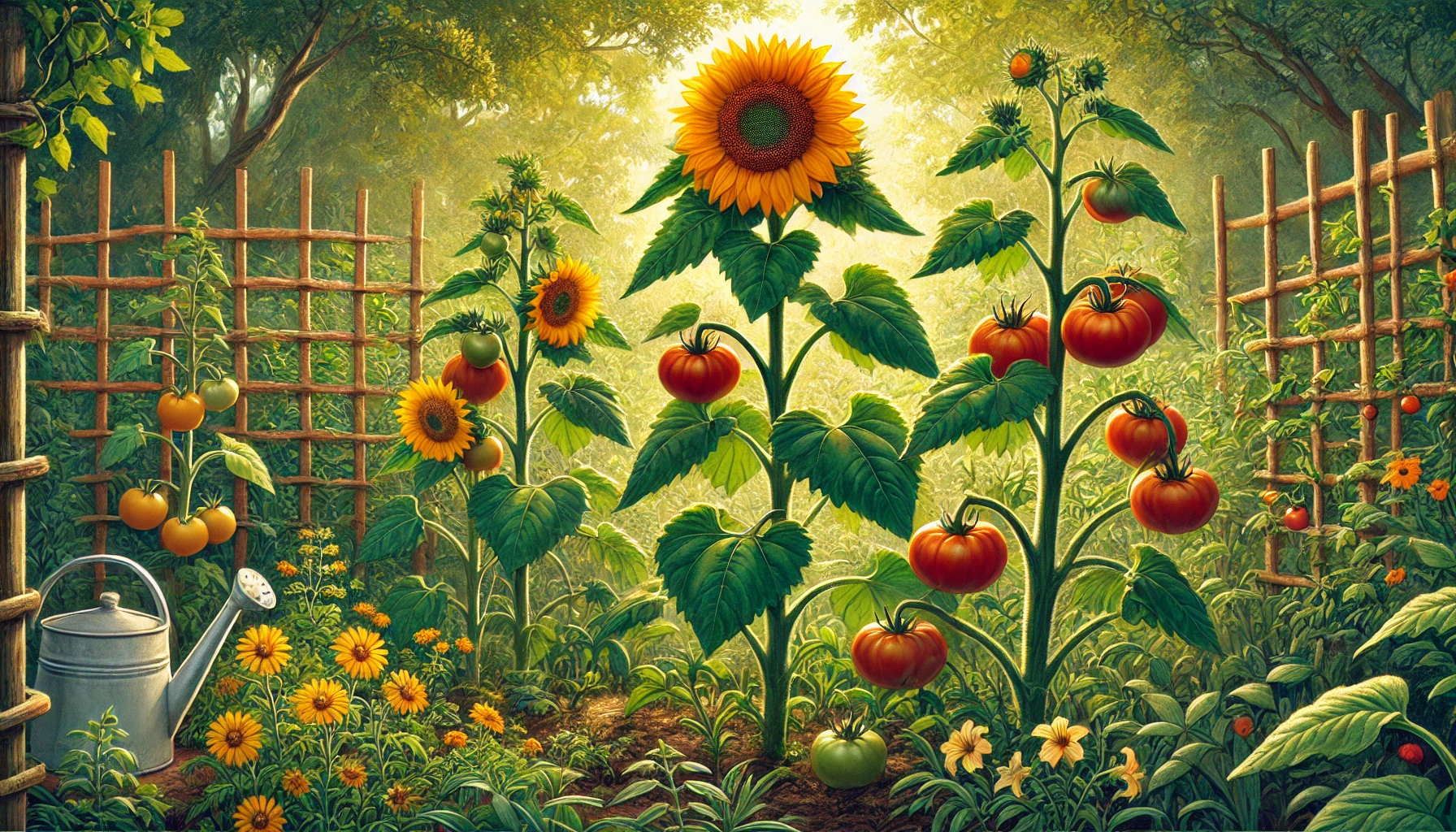We’ve discovered a winning combination in sunflowers and tomatoes, which together create a harmonious garden relationship. By pairing these plants, we benefit from improved growth, increased yields, and reduced pest and disease pressure.
Sunflowers provide shade, act as a trellis for indeterminate tomatoes, and release nutrients that benefit their tomato partners.
In return, tomatoes provide nutrients that boost sunflower growth. As we explore this partnership further, we’ll uncover the secrets to designing a perfect garden layout, preparing the soil, and providing the right care for a thriving and resilient garden ecosystem that’s teeming with life and abundance.
Key Takeaways
- Sunflowers provide shade, retain moisture, and act as a trellis for indeterminate tomatoes, promoting a symbiotic relationship.
- Tomatoes release nutrients that benefit sunflowers, leading to increased crop yields, improved soil health, and reduced pest pressure.
- Choose compact sunflower and tomato varieties, like ‘Teddy Bear’ and ‘Patio’, to ensure adequate space and air circulation.
- Plant sunflowers on the north side, 6 inches deep and 6 inches apart, after the last frost has passed and soil has warmed up to 60°F.
- Alternate rows of sunflowers and tomatoes to promote healthy air circulation, and group tomato plants by variety for easy crop rotation.
Benefits of Companion Planting
We reap numerous rewards when we pair sunflowers with tomatoes, thanks to the science-backed benefits of companion planting, which leverages the unique characteristics of each plant to create a harmonious and productive growing environment.
- By combining these two plants, we create a symbiotic relationship that fosters garden harmony.
- Sunflowers provide shade, reducing soil temperature and retaining moisture, while their tall stalks act as a trellis for indeterminate tomatoes.
- In return, tomatoes release nutrients that benefit sunflowers.
- This mutualistic relationship leads to increased crop yields, improved soil health, and reduced pest and disease pressure.
- As we cultivate this partnership, we reap the rewards of a thriving and resilient garden ecosystem.
Choosing the Right Varieties
Selecting compatible sunflower and tomato varieties is crucial to maximizing the benefits of companion planting, as different cultivars possess unique growth habits, maturation rates, and space requirements that can either harmonize or clash with one another.
We look for sunflowers with smaller flower sizing, like ‘Teddy Bear’ or ‘Sungold’, which won’t overshadow our tomatoes.
Color patterns also play a role, as bright yellow and orange sunflowers can attract pollinators, while red and pink varieties can add visual appeal to our garden.
For tomatoes, we opt for compact or dwarf varieties, such as ‘Patio’ or ‘Tiny Tim’, which require less space and can thrive beneath the sunflowers’ towering presence.
Planting Sunflowers and Tomatoes
- Plant sunflowers about 6 inches deep and 6 inches apart, after the last frost has passed and the soil has warmed up to at least 60°F.
- When planning our garden layout, we’ll want to weigh the mature size of our sunflowers and tomatoes, leaving enough space for air circulation and sunlight penetration.
- Plant sunflowers on the north side to avoid shading our tomatoes.
- Alternate rows of sunflowers and tomatoes to promote healthy air circulation.
- Group our tomato plants by variety to simplify crop rotation.
- Leave space for access paths to make harvesting and maintenance a breeze.
Soil Preparation and Care
With our sunflower and tomato layout established, we’ve set the stage for optimizing soil conditions to support their growth.
Now, it’s vital to assess our soil’s nutrient levels and pH through soil testing. This will help us identify areas that need improvement.
We’ll focus on creating a well-balanced soil structure by incorporating high-quality compost, rich in organic matter. This will enhance the soil’s water-holding capacity, aeration, and fertility, ultimately benefiting our sunflowers and tomatoes.
We’ll also guarantee our compost is rich in beneficial microorganisms, which will help break down nutrients and make them readily available to our plants.
Watering and Sunlight Requirements
As we move forward with our sunflower and tomato companion planting, we’re focusing on the critical aspects of watering and sunlight requirements.
We’ll explore the ideal soil moisture levels that benefit both plants, ensuring they receive the right amount of hydration without succumbing to waterlogged soil.
Next, we’ll discuss the perfect sun exposure needed to promote healthy growth and maximize yields.
Soil Moisture Levels
We require a delicate balance of soil moisture levels when growing sunflowers and tomatoes together, since both plants have distinct watering and sunlight needs that must be met to guarantee maximum growth and health.
To achieve this balance, we need to monitor soil moisture levels regularly.
Soil sensors: These devices measure soil moisture levels accurately and provide instant readings.
Moisture meters: They give us a precise measurement of soil moisture, helping us adjust our watering schedule accordingly.
Check the soil by inserting a finger into the soil up to the knuckle; if it feels dry, it’s time to water.
Observe plant signs: droopy leaves or yellowing can indicate overwatering, while wrinkled leaves may signal underwatering.
Optimal Sun Exposure
When growing sunflowers and tomatoes together, we need to guarantee they receive peak sun exposure, which is crucial for photosynthesis and overall plant development.
Both plants require at least six hours of direct sunlight daily, with morning sun being ideal for promoting healthy growth.
However, we must also consider the intense heat of the afternoon sun, which can be detrimental to our plants.
To strike a balance, we can provide afternoon shade, especially in warmer climates, to prevent scorching.
By doing so, we’ll create a prime environment for our sunflowers and tomatoes to thrive.
With the right amount of sun exposure, our plants will produce abundant flowers, fruits, and leaves, making our garden a vibrant and productive haven.
Natural Pest Control Methods
As we explore the benefits of sunflowers and tomatoes growing together, we’re excited to discuss how this companionship can also lead to natural pest control methods.
They can repel pests naturally, reducing the need for chemical pesticides, and attract helpful insects that prey on common tomato pests.
Repel Pests Naturally
By planting sunflowers alongside tomatoes, we can harness the natural pest-repelling properties of these flowers to create a defense system that deters pests without relying on chemical pesticides. This method of companion planting allows us to utilize natural repellents, reducing the need for synthetic pest deterrents.
Sunflowers repel pests naturally in several ways:
- Trapping aphids: Sunflowers attract aphids, drawing them away from our precious tomato crops.
- Repelling whiteflies: Sunflowers’ tall stalks and large leaves create a physical barrier, preventing whiteflies from reaching our tomatoes.
- Deterrent for nematodes: Sunflowers’ roots release chemicals that repel nematodes, microscopic worms that can harm tomatoes.
- Shielding from hornworms: Sunflowers’ towering height provides shade, making it difficult for hornworms to locate tomato plants.
Attract Helpful Insects
We can also enlist the help of beneficial insects by planting sunflowers alongside tomatoes, which attract these helpful allies to our garden.
Sunflowers, being a Butterfly Magnet, draw in these beautiful creatures that pollinate our tomatoes.
Additionally, the tall, bright yellow blooms of sunflowers make them a perfect Bee Friends, attracting honeybees and other pollinators.
By attracting these helpful insects, we can reduce our reliance on pesticides and maintain a balanced ecosystem.
As a result, our tomatoes will receive the pollination they need to thrive, and we’ll enjoy a bountiful harvest.
Supporting Indeterminate Tomatoes
We stake indeterminate tomatoes early in the season to keep them upright and promote healthy growth. This support system is vital, as indeterminate tomatoes can grow quite large and produce a high volume of fruit.
We’ve found that traditional staking methods work well, but we also like to experiment with tomato scaffolding, which provides a more extensive support system for our plants.
If you’re looking for staking alternatives, consider the following options:
- Cage method: Use wire cages to surround individual plants, providing support as they grow.
- Trellis system: Train tomato vines to climb up a trellis, keeping them upright and organized.
- Bamboo stakes: Use bamboo stakes to create a teepee structure, providing support for multiple plants.
- Grow bags: Use grow bags with built-in support systems, perfect for small-space gardening.
These methods guarantee our tomatoes receive the support they need to thrive.
Harvesting and Maintenance Tips
- As our tomatoes ripen, regular harvesting and timely maintenance become crucial to encourage continuous fruiting and prevent disease buildup.
- We make it a point to harvest our tomatoes at the right time, as leaving them on the plant for too long can lead to over-ripening and disease.
- We also guarantee our sunflowers are providing adequate shade and support to our tomato plants.
- To maintain a healthy garden, we incorporate crop rotation strategies, rotating our tomato plants to a new location each season to avoid depleting the soil of its nutrients.
- Additionally, we utilize season extension techniques, such as using row covers, to extend our harvest period and enjoy a longer growing season.
Common Challenges and Solutions
Three common obstacles that can hinder the success of our sunflower and tomato companion planting are pests, nutrient deficiencies, and inadequate support structures.
We’ve found that these challenges can be particularly frustrating when they impact our harvest.
To overcome these issues, we’ve developed some effective solutions:
Use natural pest control methods: Encourage beneficial insects, such as ladybugs and lacewings, to prey on garden pests.
Conduct regular soil tests: Monitor nutrient levels and adjust our fertilization schedule accordingly.
Install trellises and stakes: Provide adequate support for our sunflowers and tomato plants to prevent soil erosion and promote healthy growth.
Implement crop rotation: Rotate our crops seasonally to break disease and pest cycles.
Conclusion
As we bid farewell to our sunflower and tomato duo, we’re left with a sense of harmony, like a symphony of growth and abundance.
Our garden, once a blank canvas, is now a vibrant tapestry of color and life.
By embracing the art of companion planting, we’ve woven a delicate balance of nature, nurturing a thriving ecosystem that’s as resilient as it’s bountiful.
And as we savor the fruits of our labor, we’re reminded that in the garden, beauty and functionality entwine like the tender vines of our beloved tomatoes.
Frequently Asked Questions
Can I Grow Sunflowers and Tomatoes in Containers Together?
We can grow sunflowers and tomatoes in containers together, but we’ll need a deep container (at least 12-18 inches) with a well-draining mix, and carefully mix soil to accommodate both plants’ needs, ensuring adequate root space.
How Far Apart Should I Plant Sunflowers and Tomatoes?
We’re about to dig into the most epic garden setup ever! For ideal growth, we’ll plant sunflowers 12-18 inches apart and tomatoes 2-3 feet away, ensuring proper soil preparation and adequate plant spacing for a thriving container garden.
Will Sunflowers Shade Out My Tomato Plants?
We consider sunflower height when planting tomatoes nearby, as taller varieties can cast shade, affecting tomato growth; understanding shade dynamics helps us strategically place our plants to maximize sunlight and promote healthy growth.
Do Sunflowers Attract Beneficial Insects for Tomatoes?
“We’re thrilled to report that sunflowers are like beneficial bee magnets! They attract a plethora of insect attractants, ensuring a constant buzz of helpful activity around our tomatoes, which ultimately boosts their growth and health!”
Can I Use Sunflowers as a Trellis for Climbing Tomatoes?
We can definitely use sunflowers as a trellis for climbing tomatoes, but we need to guarantee sunflower stability by staking them first, then providing proper tomato support with twine or clips for a sturdy structure.

